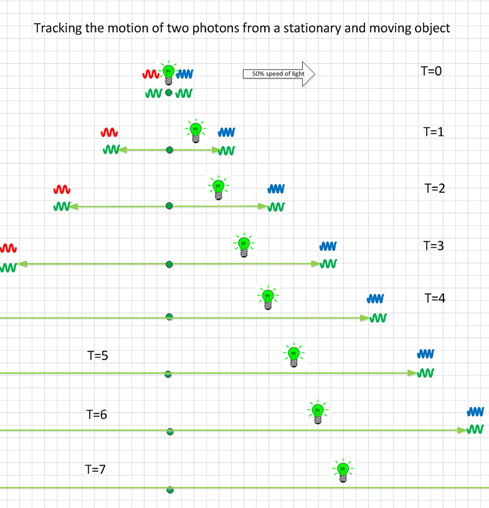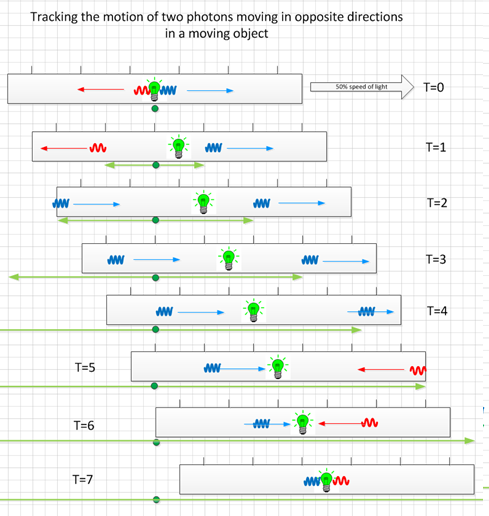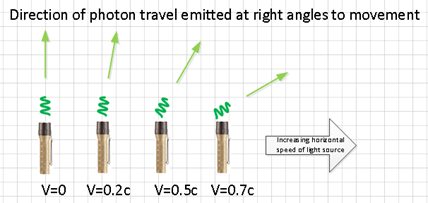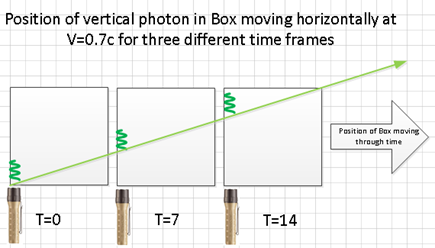Yes. The one way speed of light can approach instantaneous (but will never reach it) BUT only if you ignore or abandon something called Relativity of Simultaneity.
One way speed of light (OWSOL) is the antithesis of Relativity of Simultaneity. The two can’t coexist. There does however seem to still be some interest in promoting One way speed of light, and breaking some laws of physics that stand in its way. The Veritasium video has over 17 million views, and over 100,000 comments (July/2022). Interestingly, the YouTube video asks the question ‘is it possible?’ without ever offering any clues indicating how you would actually answer the question.
So, just for fun, and hypothetically speaking, here is one possible way of calculating the one-way speed of light, ignoring Relativity of Simultaneity in the process.
. . .
Below is a thought experiment where I have drawn out the position of one way light though time frames [T0 – T7] in two different but similar situations: Light behavior in open space, and light behavior within an enclosed object moving through space.
The 2nd diagram indicates that the one-way speed of light (OWSOL) as shown in the moving frame of reference is not constant.
As shown within the moving object in Diagram 2, the photon moving in the forward direction of travel will hit the front wall later in time than the photon moving in the reverse direction of travel hits the back wall.
As the moving object’s speed approaches the speed of light, the photon’s speed in the forward direction (measured against the moving object) approaches zero, while the photon’s speed in the reverse direction approaches instantaneous.
Diagram 1: The light bulb is traveling through space moving at 50% the speed of light to the right. The second green dot light bulb is stationary. Photons are emitted from the moving and stationary light bulbs in the forward and reverse direction at exactly the same time as they pass each other in space.

Photons emitted from the moving light bulb are blue shifted in the forward direction, and red shifted in the reverse direction.
Photons emitted from the stationary light bulb are not frequency shifted, but travel through space at exactly the same speed as the frequency shifted photons.
Diagram 2: Same diagram as above, but now with a wire frame box centered around the moving light bulb.
The speed of light plotted inside the moving box is the same as the speed of light plotted outside of the moving box, as the absolute speed of light is constant in all frames of reference.

Observation: From the perspective of a person standing inside the box, the forward one-way speed of light in the moving frame of reference (blue photon) is considerably slower than the reversed one-way speed of light (red photon). The two-way speed of light remains constant in all directions.
Advanced Notes: Assume the diagrams are from a computer simulation, and that the simulation can be stopped at any point in time to view the exact location of the photon (Ignores the issues of simultaneity, but still allows us to discuss what’s happening outside of the box, and what is happening inside the box). Also assume that the correct Lorentz adjustment have been made to the moving object, where to the outside observer in the stationary frame, as the speed of the object passing through space approaches c, within the moving object time comes to a stop, and the horizontal contracted length of the object approaches zero.
Supporting Proof:
Below are two diagrams showing the direction light travels when emitted at 90 degrees to the direction of travel.
Diagram 3:
Diagram 3 shows a flashlight traveling at different horizontal velocities through space emitting light in in a vertical direction.

Diagram 4:
Diagram 4 plots an emitted photon as it travels upwards inside an enclosed box moving right at 0.7c

I'm making the point that the the behavior of a photon in a vacuum emitted in the rest frame, and a photon emitted in a moving frame, is the same. The location of the photon plotted against the rest frame is in the same location in space as the photon plotted against the overlaid moving frame of reference. This relationship has a basis in physics, and can be used to derive the Lorentz factor. Link:( https://medium.com/physics-scribbles/deriving-the-lorentz-factor-%CE%B3-of-special-relativity-d5462f3b3b91)
Once launched, the only thing that can change the direction of travel of the photon is to be absorbed, reflected, pass through a transparent medium, or pass through a gravitational field.
So to establish the mathematical framework for the behavior of the photon in the moving object frame, one need only plot the behavior of the photon in the rest frame, and then map that position to the moving object frame, taking into account any objects or walls that the photon hits or bounces off of.
Referring to figure 2, to establish the time and position in the rest frame of when the released photon hits the right side of the box, all we need to do is set up the relationship for distance traveled, taking into account the fact that as a frame of reference approaches the speed of light, in that frame, time slows down, and the object contracts in length in the direction of travel.
If the length of the front half of the box at rest is 1 light-second, and the Lorentz factor at 50% the speed of light is 0.8660, then:
Calculation for when the released photon hits the right side of the box:
Speed of light * time = (speed of the right side of the box * time)
+ Lorentz modified length of the box.
c * t = (0.5c * t) + 0.866025
0.5t = 0.866025
t = 1.732051
The photon hits the right side of the box at time t=1.732051 in the rest frame.
A similar calculation for when the released photon hits the left side of the box:
Reverse Speed of light * time = (speed of the left side of the box * time)
– Lorentz modified length of the box.
-c * t = (0.5c * t) – 0.866025
-1.5t = - 0.866025
t = 0.57735
The photon hits the left side of the box at time t=0.57735 in the rest frame.
On the return trip, the now forward traveling photon takes 1.732051 seconds to reach the center of the box, and the now reverse traveling photon takes 0.57735 seconds to reach the center of the box, for a total 2-way speed for both photons of 1.732051 + 0.57735 seconds = 2.309401 seconds.
Doing the translation to the moving frame of reference, multiplying by the Lorentz factor 0.866, gives a moving frame of reference time for the speed of two-way light of 2.309401 * 0.866 = 2 seconds in the moving box. The one-way time to reach the right side of the box is 1.732051 * 0.866025 = 1.5 seconds.
The one-way time to reach the left side of the box is 0.57735 * 0.866 = 0.5 seconds.
Within the moving frame of reference the speed of light in the forward direction is 1 light second of distance traveled in 1.5 seconds = 0.66667x the speed of light. In the reverse direction, the photon travels 1 light second in 0.5 seconds = 2x the speed of light.
As the moving box approaches the speed of light, the speed of the forward moving photon in the moving box frame of reference approaches an internal time of 2 seconds (50% the speed of light), and a reverse direction speed of close to instantaneous.
Note that if the box travels at 99.99% the speed of light, the measured time to travel 1 light second in the forward direction as measured in the rest frame is 2 / 0.0141 = 142 seconds. At 99.9999% the speed of light, The value is 2 / 0.00141 = 1418 seconds, and goes up exponentially from there.
Supplemental note:
Relativity of Simultaneity postulates that in each reference frame, one-way light travels at the speed of c, and any appearance otherwise is the difference between an actual and a perceived event, in that you can only measure the perceived event. If a calculation leads to two possible outcomes (differences in what two different observers see), this is known as a paradox of simultaneity. That leaves it up to you to decide which calculated answer is correct.
Trying to build a computer simulation of a complex behavior mapping multiple moving frames of reference interacting with a photon, all the while incorporating Relativity of Simultaneity, is a nightmare. I’m not even sure it can be done. My understanding is that the most complex synchronized set of clocks ever built, known as GPS, does not use Relativity of Simultaneity in its calculations.
As a thought experiment, if you were to imagine a world where ‘Relativity of Simultaneity’ did not exist, what terrible things would happen?
- The world you live in would continue to exist as it does today.
- The GPS satellite system would continue to operate unmodified, as it does not use ‘Relativity of Simultaneity’ in any of its calculations involving spacetime.
- The derivation of the Lorentz Factor would remain the same, as the Lorentz factor does not rely on the concept of ‘Relativity of Simultaneity’ in order to correctly calculate time dilation or length contraction differences between moving frames of reference.
- The speed of light c remains a constant in the rest frame.
- The two-way speed of light c continues to be a constant in all frames of reference.
- Physics would have to recognize the one-way speed of light, which is c in the rest frame, but can be less than c, or more than c as measured in a moving frame, dependent on the direction of travel of the photon relative to the local frame, and the direction of travel of the local frame relative to the rest frame.
- All the paradoxes of special relativity would suddenly resolve themselves, and cease to exist.
- Simulations of the universe can go back to predicting the location and time that events occur in ‘all frames of reference’ without having to pretend it’s OK that an event may or may not occur in two different places, or at two different times, depending on who’s perspective is used of the multitude of people who are viewing the event.
- It becomes possible to identify ‘the absolute rest frame’, closer aligning classical physics with quantum physics. That also opens a logical path back to absolute time, and absolute location.
The issue being, no one has figured out a way to measure the one-way speed of light, or how to synchronize clocks, and Relativity of Simultaneity says that doing so is impossible, so don’t even bother trying. However, in an imagined world without Simultaneity, I wonder if that limitation would still be true?




